Ancient Egyptian Pharaohs FAQ
Ancient Egyptian pharaohs were considered to be both divine deities and mortal rulers. Throughout the 30+ dynasties in ancient Egyptian history, it is speculated that some 170 or more rulers reigned over the great land of Egypt during a three thousand year time span. The throne of Egypt was primarily intended to be succeeded from father to son, however in many cases this line of kingship was interrupted by murder, mayhem and mysterious disappearances.
Who were the pharaohs and how many were there?
The pharaohs were the rulers of ancient Egypt and each pharaoh was the most powerful person in the kingdom. Ancient Egypt had approximately 190 pharaohs, according to the Metropolitan Museum of Art, and their rule spanned the time from about 2649 B.C. until about 30 B.C., when the Romans conquered Egypt.
During the intermediate periods, there were sometimes more than one dynasty ruling simultaneously, so there could be a ruler in each area. Whether the pharaoh was a man or a woman, the title was pharaoh.
Pharaonic rule is split into periods, which are:
- Old Kingdom: 2649 B.C. to 2150 B.C.
- First Intermediate Period: 2150 B.C. to 2030 B.C.
- Middle Kingdom: 2130 B.C. to 1640 B.C.
- Second Intermediate Period: 1640 B.C. to 1540 B.C.
- New Kingdom: 1540 B.C. to 1070 B.C.
- High Priests of Amun: 1080 B.C. to 1070 B.C.
- Third Intermediate Period: 1070 B.C. to 713 B.C.
- Late Period: 713 B.C. to 332 B.C.
- Macedonian Period: 332 B.C. to 304 B.C.
- Ptolemaic Period: 304 B.C. to 30 B.C.
Were all pharaohs men?
Most of the pharaohs were men, but history shows ten female pharaohs:
Queen MerNeith

Senior royal wife of Djet, Merneith was the first recorded queen regnant in Egypt's 1st Dynasty.
Nitocris
Daughter of Queen Neith and Pepi II and may have been the last pharaoh of the 6th Dynasty. Details about her life are undocumented, but, according to various theories, she supposedly either:
- Killed her brother's killer by inviting him to dinner and then flooding the room
- Built the third pyramid at Giza
- Was actually male
- Went by the name Nitiqrty or Neterkare, or
- Never existed
Ahhotep I
Her name means "the moon is satisfied" and she ruled at the end of the 17th Dynasty. She was the daughter of Senakhtenre Ahomse and Queen Tetisheri.
Neferneferuaten
Parts of her name mean "effective for her husband" and she ruled independently for three years.
Khentkaus I
The daughter of the pharaoh Menkaure, she was the wife of Shepseskaf and the wife of King Userkaf. It's believed that she was the oldest queen to use the title of King of Lower and Upper Egypt, although ancient Egyptians seldom lived past the age of 40.
Queen Twosret
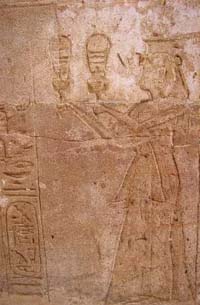
She was the last pharaoh of the 19th Dynasty and ruled independently for two years. She allegedly sent expeditions to turquoise mines in Palestine and Sinai. Her tomb was usurped by Setnakht and her sarcophagus was taken for use by Amenherkhepeshef.
Queen Sobekneferu
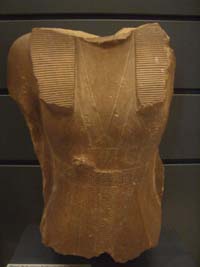
She ruled from 1806 B.C. to 1802 B.C. Most of her monuments and statues have been destroyed, although one of them shows her wearing both male and female garments. Her burial site is unknown.
Queen Hatshepsut
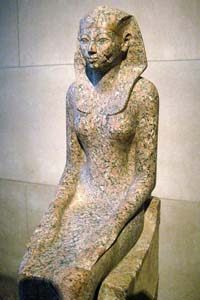
One of Egypt's most prolific builders, she ruled for 22 years and is often depicted wearing men's clothing and the false beard worn by the pharaohs Considered one of Egypt's greatest pharaohs, she was the 5th pharaoh of the 18th Dynasty.
Queen Nefertiti
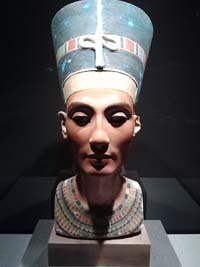
The Great Royal Wife of Pharaoh Akhenaten and step-mother of King Tutankhamun. She bore six daughters and disappears from records in Akhenaten's 12th regnal year. She is thought to either have died, or become co-regent with her husband.
Queen Cleopatra
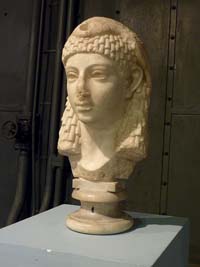
The last active pharaoh, Cleopatra ruled with her father Ptolemy XII, and later with her brothers, Ptolemy XIII and Ptolemy XIV. Her romantic liasion with Mark Antony yielded two sons and one daughter; Cleopatra ultimately killed herself with a poisonous asp.
Who were the most famous male pharaohs?
Tutankhamun
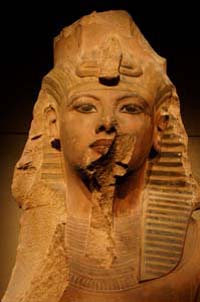
By far, the most famous of the pharaohs would be the boy king, Tutankhamun, often referred to as King Tut. He ascended the throne around age 9 and ruled for about 10 years; he died around 1324 B.C., and the most current forensic evidence indicates that his death was the result of an infection that set in after he broke his right leg.
King Tut was frail and had many health issues. Rather than the tall, virile image of a young man that's normally depicted, his left foot was clubbed, he had multiple strains of malaria, a compromised immune system, and a fractured left femur. He walked with a cane, and several of them were in his tomb.
His compromised immune system would have prevented his body from fighting an infection, it's thought that the infection was responsible for his death. The small hole in the back of his skull has been attributed to workers who were working on his sarcophagus rather than the result of an attempted murder.
King Tut's father was Akhenaten, the heretic king, and his mother was also his aunt, one of his father's sisters. Although the ancient Egyptians thought that incest would keep the bloodline pure, it's now known that incest results in deformities and health issues, which was likely the reason for some of Tut's health issues.
Amenhotep IV/Akhenaten
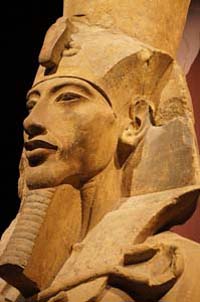
One of Egypt's most controversial pharaohs, Akhenaten is known as the heretic king because he abandoned Egypt's polytheistic religious practices in favor of a monotheistic religion, which was worship of the sun god Ra.
Ramses II
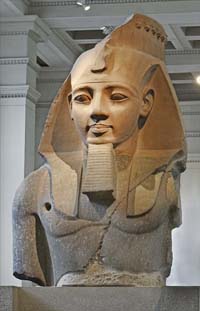
Ruling the New Kingdom for more than 60 years, Ramses II is considered one of the most prolific of the pharaohs. He fathered more than 150 children with his wives and concubines. Many of his temples and statues are relatively intact and are located throughout Egypt.
Ramses III
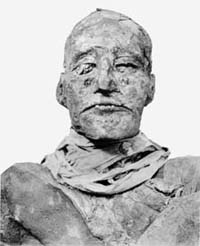
Considered to be the last great pharaoh, Ramses III ruled for more than 30 years, until he had the unfortunate luck to be murdered by one of his wives. His rule was tumultuous with wars, homelessness, a decline in Egypt's power, and internal strife.
Khufu
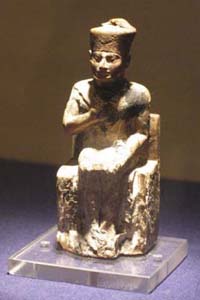
Also known as Cheops, he was the builder of the Great Pyramid at Giza and ruled during the 4th Dynasty of the Old Kingdom.
Thutmose III
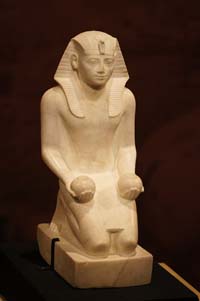
Ruling Egypt for 45 years, Thutmose III created the most massive empire in Egypt's history, amassing considerable wealth. He's often referred to as the Napoleon of ancient Egypt and is considered to be the best pharaoh in Egypt's history. He ruled during the 18th dynasty as the 6th pharaoh and was buried in the Valley of the Kings in 1425 B.C.
Amenhotep III

The son of Thutmose IV, Amenhotep III ruled for almost 40 years during the 18th Dynasty as the 9th pharaoh. His prosperous and peaceful reign is referred to as the Golden Age of Egypt.
Additional notable pharaohs include:
- Narmer, who united Upper and Lower Egypt.
- Menes, who founded the 1st Dynasty.
- Djoser, who built the step pyramid.
- Snefru, who built the first true pyramid. Its structural flaws necessitated design changes.
- Khafre, who built Giza's second largest pyramid and implemented a tax system that enabled the citizens to build the pyramids.
- Neferefre, who left a cache of papyri from his reign, which provided valuable information about administrative, economic, and religious practices during his reign.
- Pepi II, who was Egypt's longest ruling pharaoh. The first 50 years were peaceful and prosperous, the second half were rife with internal strife and economic issues.
- Senusret I, who had a peaceful reign. A notable achievement was irrigation of the Faiyum to increase the arable land area. His statues reflect his actual appearance, which started a trend in depicting pharaohs.
- Ahmose I, who attempted to reunify Egypt during the 18th Dynasty, and banish the Hyksos.
- Amenhotep I, the son of Ahmose I, continued his father's reunification efforts and greatly enhanced the wealth of the treasury.
- Thutmose II, ruled briefly and his wife, Queen Hatshepsut, sought to place her name on all his monuments. Thutmose II was frail, with illnesses that are thought to have been responsible for his death.
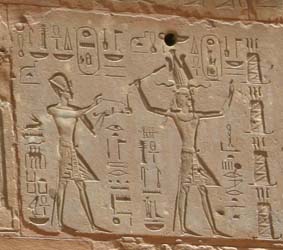
Thutmose II (left) and Hatshepsut (right)
What was the relationship between the pharaoh and the people?
The pharaoh was seen as the mediator between the people and the gods. During a pharaoh's rule, he was considered to be the incarnation of Horus; upon his death, he became part of the sun god.
The staff that a pharaoh holds refers to the crook a shepherd uses to keep his sheep in line and close to the flock. The small whip that he holds is a flail, which symbolizes that a pharaoh needs to keep his people moral and upright.
How many wives did pharaohs have?
A pharaoh could have as many wives as he wanted, but there was only one great royal wife, who served as his queen. Due to the high infant mortality rate, pharaohs fathered children with many wives and concubines in order to ensure the longevity of his lineage. Since inbreeding produced so many stillborn children and so many deformities, the pharaohs were unwittingly ensuring the longevity of their lineage.
Female pharaohs were not permitted to have multiple husbands.
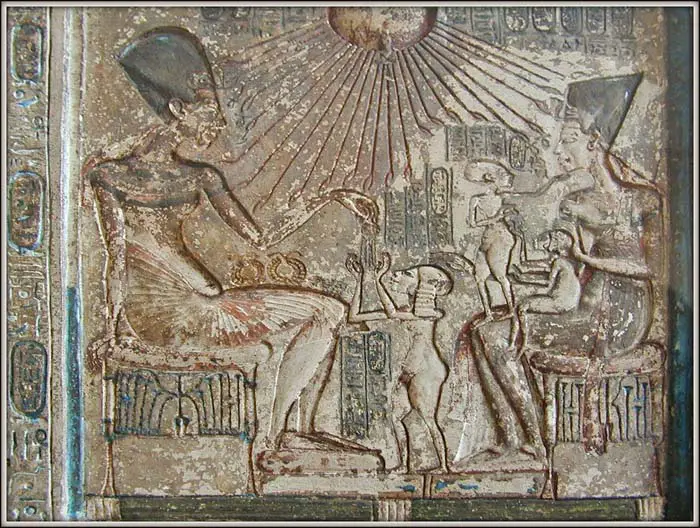
© Jean-Pierre Dalbéra - Depiction of Akhenaten and his family
What was the purpose of a death mask?
Ancient Egyptians believed that souls would return to the body after death, so it was vitally important for the soul to recognize the body to which it belonged. Death masks were made from precious metals, and showed a slight smile; makeup was in the style of the time.
When did the pharaohs erect their tombs?
When a pharaoh ascended the throne, he or she began to construct his or her pyramid or tomb and plan for its contents. Often, tombs or pyramids were confiscated by later rulers and used for their own burial chambers.
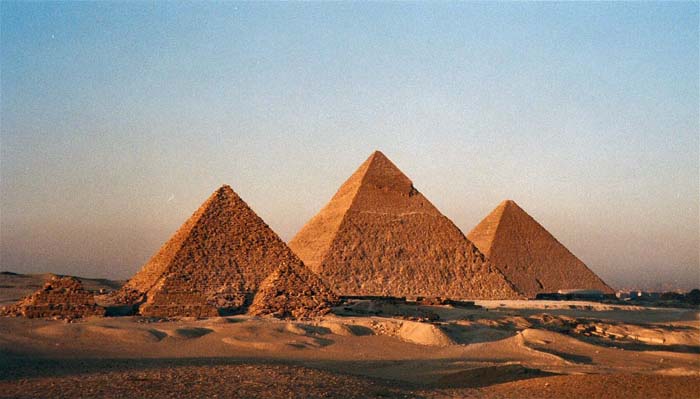
© Bruno Girin - The pyramids of Khufu, Khafre and Menkaure
What did the pharaohs wear?
Pharaohs wore fine linen kilts that were wrapped at the waist and another cloth that was draped over the shoulder, a highly decorated apron called a shendyt, and occasionally, a leopard skin on the shoulder. Pharaohs wore expensive jewelry on all parts of their bodies.
Hair was cropped short in order to prevent an infestation of lice, so most pharaohs wore wigs; both male and female pharaohs wore eye makeup.
Did the pharaohs have a role in religious practices?
A pharaoh was the religious high priest as well as the commander in chief of the army. Pharaohs made offerings to the gods on a daily basis to ensure that the Nile flooded on time. Only the high priest and priests were permitted to enter the temples.
All citizens had to prostrate themselves before the king.

© Héctor de Pereda - The temples at Abu Simbel
Who was the last pharaoh?
Cleopatra, one of the most famous pharaohs, was also the last of the pharaohs, and died by her own hand as a result of her tumultuous liaison with Mark Antony.
